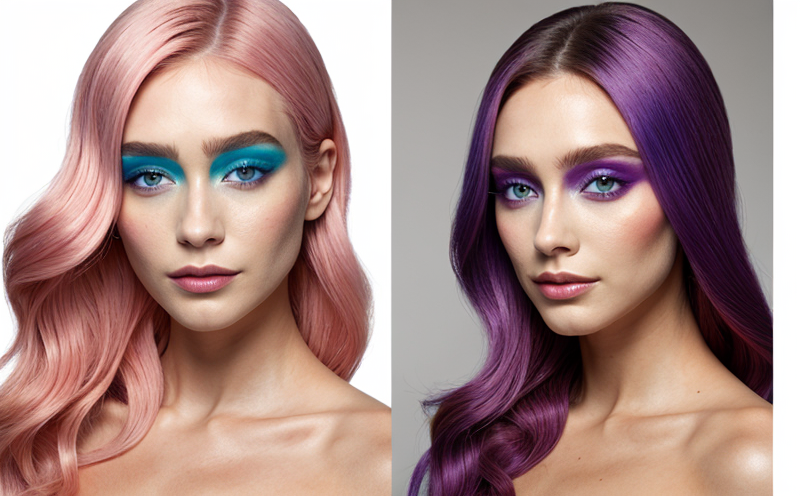Photostability Testing of Cosmetic Pigments
The photostability testing of cosmetic pigments is a critical process that ensures color cosmetics maintain their visual integrity and chemical stability under various environmental conditions. This service is essential for quality managers, compliance officers, R&D engineers, and procurement teams to ensure the safety, effectiveness, and consumer satisfaction of their products.
Photostability refers to the resistance of pigments to degradation caused by exposure to light. The process involves simulating real-world conditions where the pigment might be exposed to sunlight or other forms of ultraviolet (UV) radiation during product use. This testing is vital because cosmetic formulations, especially those with high concentrations of pigments, are susceptible to photodegradation, which can lead to changes in color hue and intensity.
The test typically involves exposing a sample of the pigment to specific wavelengths of light for predetermined durations under controlled conditions. The goal is to assess how well the pigment withstands these exposures without undergoing significant chemical or physical changes that could affect product performance and safety.
For instance, certain pigments used in lipsticks, eyeliners, and mascaras may degrade over time when exposed to UV light, leading to discoloration or loss of color intensity. This degradation can diminish the aesthetic appeal of the cosmetic product and potentially impact its efficacy if it affects the pigment's intended function.
The testing process is standardized and regulated by international standards such as ISO 17652-1, which specifies the requirements for photostability testing of pigments used in color cosmetics. Compliance with these standards ensures that the test results are reliable and comparable across different laboratories and regions.
During the testing, samples are prepared according to specific protocols, ensuring consistency in the test conditions. The samples are then exposed to artificial light sources designed to mimic natural sunlight or other relevant illumination conditions. The intensity and duration of exposure vary depending on the pigment type and its intended use.
The results of photostability tests provide valuable insights into the long-term stability of pigments, helping manufacturers make informed decisions about ingredient selection and formulation design. By understanding how different factors affect pigment stability, companies can optimize their product formulations to enhance shelf life and performance. This not only benefits the manufacturer but also contributes positively to consumer safety by preventing potentially harmful or aesthetically displeasing products from reaching the market.
Photostability testing is a key component of quality assurance programs in the cosmetics industry. It helps ensure that color cosmetics meet regulatory requirements and maintain their intended performance over time, thereby safeguarding both the manufacturer's reputation and consumer satisfaction.
Applied Standards
- ISO 17652-1:2019 - Requirements for Photostability Testing of Pigments Used in Color Cosmetics
- ASTM D4588 - Practice for Photostability Testing of Cosmetic Products and Their Ingredients
- EN 16732:2019 - Cosmetics - Determination of photostability of pigments used in color cosmetics
- IEC 61262-4 - Photostability Testing of Pigments Used in Color Cosmetics
The application of these standards ensures that the testing process is consistent and reliable, providing accurate data for decision-making purposes.
Benefits
Photostability testing offers several benefits to businesses operating within the cosmetics sector. Firstly, it enhances product quality by ensuring that pigments remain stable under various environmental conditions, thus maintaining the desired color and performance characteristics of cosmetic products.
- Improved Product Quality: Ensures consistent pigment stability across different batches and formulations.
- Enhanced Consumer Satisfaction: Guarantees that consumers receive products with expected visual qualities, leading to higher customer satisfaction.
- Regulatory Compliance: Helps companies meet international standards and regulations related to color cosmetics.
- Informed Formulation Design: Provides valuable data for optimizing product formulations to enhance longevity and performance.
The ability to predict and control the stability of pigments under real-world conditions is crucial for maintaining brand integrity and fostering trust among consumers. By investing in photostability testing, businesses can stay ahead of market trends and regulatory requirements while delivering high-quality products that meet or exceed customer expectations.
Quality and Reliability Assurance
The reliability and quality assurance processes involved in photostability testing are comprehensive. The testing begins with the selection of appropriate light sources, which must accurately simulate natural sunlight to ensure realistic results.
- Light Sources: Typically include xenon lamps or LED arrays designed to emit UV-A and UV-B radiation that mimic solar spectrum conditions.
- Environmental Control: Maintains constant temperature and humidity levels to replicate real-world storage conditions.
- Spectrophotometric Analysis: Measures color changes over time, providing quantitative data on pigment stability.
The testing process is highly controlled, with strict adherence to standardized protocols. This ensures that the results are accurate, repeatable, and reliable. Additionally, ongoing quality checks are performed at various stages of the test to ensure consistency and integrity of the data collected.
By implementing these rigorous quality assurance measures, laboratories can provide clients with confidence in the accuracy and reliability of their photostability testing services. This not only enhances trust between the laboratory and its customers but also contributes to the overall success of cosmetic products by ensuring they meet high standards of quality and performance.





